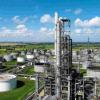|
|
Heat Of Condensation Of Hydrocarbons
Started by Butterfly, Sep 12 2011 01:18 PM
7 replies to this topic
Share this topic:
#1

Posted 12 September 2011 - 01:18 PM
Hello
I have a gas flow which is a mixture of hydrocarbons (2 phase flow). In order to adjust the dew point and get the gas into the needed specification, a refrigeration cycle using propane will be used. The gas stream is at a Pressure of about 70 bar, and it will be cooled down in a Chiller, exchanging with the propane stream, from 8 degrees celsius to -11 deg.
I made a simulation in Hysys, and got the duty in the Chiller. Now, I need to calculate the duty by using the common formula, to other purposes. Since there are condensing hydrocarbons I used:
Q = m·Cp·(T2-T1) + mcond·L
Where Q is the heat exchanged, m the total mass flow, mcondens the mass of the liquid that condensed in the cooling (taking into account that there was already some liquid in the inlet flow) and L the latent heat of condensation.
My problem is that by using the formula I dont get the same value that if I read the duty of the exchanger.
I got all from hysys. I even took the averaged Cp between the inlet and outlet stream.
I fear the problem is in the latent heat for the condensation of hydrocarbons. In Hysys properties, I can read the Heat of vaporization for a stream (kJ/kmol). It is the same for the inlet and outlet. This was the value I used for L.
I want to get the value of Q as a function of T1, and see if I can assume that for small changes of this temperature from the base values, mcond·L is constant
It also occurred to me to read the duty from hysys, then calculate m·Cp·(T2-T1), and the difference will be mcond·L. With the value of mcond, I could get L. I dont know if that would be correct.
Thanks
I have a gas flow which is a mixture of hydrocarbons (2 phase flow). In order to adjust the dew point and get the gas into the needed specification, a refrigeration cycle using propane will be used. The gas stream is at a Pressure of about 70 bar, and it will be cooled down in a Chiller, exchanging with the propane stream, from 8 degrees celsius to -11 deg.
I made a simulation in Hysys, and got the duty in the Chiller. Now, I need to calculate the duty by using the common formula, to other purposes. Since there are condensing hydrocarbons I used:
Q = m·Cp·(T2-T1) + mcond·L
Where Q is the heat exchanged, m the total mass flow, mcondens the mass of the liquid that condensed in the cooling (taking into account that there was already some liquid in the inlet flow) and L the latent heat of condensation.
My problem is that by using the formula I dont get the same value that if I read the duty of the exchanger.
I got all from hysys. I even took the averaged Cp between the inlet and outlet stream.
I fear the problem is in the latent heat for the condensation of hydrocarbons. In Hysys properties, I can read the Heat of vaporization for a stream (kJ/kmol). It is the same for the inlet and outlet. This was the value I used for L.
I want to get the value of Q as a function of T1, and see if I can assume that for small changes of this temperature from the base values, mcond·L is constant
It also occurred to me to read the duty from hysys, then calculate m·Cp·(T2-T1), and the difference will be mcond·L. With the value of mcond, I could get L. I dont know if that would be correct.
Thanks
#2

Posted 12 September 2011 - 02:34 PM
Probably a model based on average properties can gives poor results, supposing the heat exchanger has three zones (from gas inlet to subcooled liquid out)
desuperheating area m*gcpm(tin-td)
condensing area m*hvm
subcooling area m*lcmp(tb-tout)where
gcpm average specific heat for gas
tin inlet temperature
td dew point
hvm average heat of vaporization for that mixture
tb bubble point
tout outlet temperature
lcpm average specific heat for liquid
the main problem is that if the composition of condensing stream changes you have to recalculate all average properties, dew point and bubble point.
In my opinion a better approach would be to define a simplified temperature dependent model for each component in the mixture, say
for heat balance
CPGi, CPLi = Ai + Bi*T (Ai,Bi calculated for each component)
for vapor liquid equilibria
cki = exp(Kai*Kbi/T)
where cki = fgi/fli
once you have calculated the parameters for the simplified model it will be easy to esitimate dew point, bubble point and liquid fractions in condensation area.
Calculating the simplified model is not difficult if your simulator returns properties and derivatives, the advantage being that you can estimate average properties (from simplified model) when composition changes.
desuperheating area m*gcpm(tin-td)
condensing area m*hvm
subcooling area m*lcmp(tb-tout)where
gcpm average specific heat for gas
tin inlet temperature
td dew point
hvm average heat of vaporization for that mixture
tb bubble point
tout outlet temperature
lcpm average specific heat for liquid
the main problem is that if the composition of condensing stream changes you have to recalculate all average properties, dew point and bubble point.
In my opinion a better approach would be to define a simplified temperature dependent model for each component in the mixture, say
for heat balance
CPGi, CPLi = Ai + Bi*T (Ai,Bi calculated for each component)
for vapor liquid equilibria
cki = exp(Kai*Kbi/T)
where cki = fgi/fli
once you have calculated the parameters for the simplified model it will be easy to esitimate dew point, bubble point and liquid fractions in condensation area.
Calculating the simplified model is not difficult if your simulator returns properties and derivatives, the advantage being that you can estimate average properties (from simplified model) when composition changes.
Edited by PaoloPemi, 12 September 2011 - 11:25 PM.
#3

Posted 12 September 2011 - 09:08 PM
Please take note that condensation of hydrocarbon mixture occurs over a range of temperature. It is not like a single component.
I suggest you use enthalpy balance.
Difficult to pin-point your problem without looking at the detailed calculation. Attach your calculation for review by others in this forum.
I suggest you use enthalpy balance.
Difficult to pin-point your problem without looking at the detailed calculation. Attach your calculation for review by others in this forum.
Edited by S.AHMAD, 12 September 2011 - 09:11 PM.
#4

Posted 12 September 2011 - 11:13 PM
Paolopemi and S.AHMAD are correct, for mixtures methods based on averaged properties
desuperheating area m*gcp(tin-td)
condensing area m*hvm
subcooling area m*lcp(tb-tout)
give correct results only for a specific composition and conditions (those at which these properties have been determined).
The method based on a simplified model recalls me the Kb method by Boston and Sullivan, is that correct ?
desuperheating area m*gcp(tin-td)
condensing area m*hvm
subcooling area m*lcp(tb-tout)
give correct results only for a specific composition and conditions (those at which these properties have been determined).
The method based on a simplified model recalls me the Kb method by Boston and Sullivan, is that correct ?
Edited by marchem, 12 September 2011 - 11:16 PM.
#5

Posted 13 September 2011 - 12:53 PM
Hello
Thanks for your replies. Yes, you are right pointing out that in a mixture condensing temperature is not constant, thank you for remembering.
I can express the Cp of a component as a function of temperature, and so the average for my hydrocarbon mixture. I think doing the same for the heat of condensation is not so easy, is it? Here would go what you suggest about the Kb method
In my problem, both, inlet and outlet are in the two-phase zone. This makes me now think that I dont have the "sensible cooling" section, just condensing.
Can I get a value for the heat of vaporization? Or should I just look at the enthalpy values in hysys, and the difference gives me the answer (as Ahmad suggests)?
I enclose here the hysys simulation, and excel file with the results. It is a very simple case. I think the value I get from hysys for the Heat of vaporization may be wrong. I dont get the duty value if I multiply this heat by the condensing mass
Sorry, I cannot attach the Hysys file. Well, I copied the main values in he excel one.
Thanks again for your help
Thanks for your replies. Yes, you are right pointing out that in a mixture condensing temperature is not constant, thank you for remembering.
I can express the Cp of a component as a function of temperature, and so the average for my hydrocarbon mixture. I think doing the same for the heat of condensation is not so easy, is it? Here would go what you suggest about the Kb method
In my problem, both, inlet and outlet are in the two-phase zone. This makes me now think that I dont have the "sensible cooling" section, just condensing.
Can I get a value for the heat of vaporization? Or should I just look at the enthalpy values in hysys, and the difference gives me the answer (as Ahmad suggests)?
I enclose here the hysys simulation, and excel file with the results. It is a very simple case. I think the value I get from hysys for the Heat of vaporization may be wrong. I dont get the duty value if I multiply this heat by the condensing mass
Sorry, I cannot attach the Hysys file. Well, I copied the main values in he excel one.
Thanks again for your help
Attached Files
#6

Posted 13 September 2011 - 02:25 PM
You should be able to verify mass & heat balance
mlin*Hlin + mvin*Hvin - (mlout*Hlout + mvout*Hvout + HDuty) = 0
mlin (inlet) liquid mass flow
Hlin (inlet) liquid enthalpy
mvin (inlet) vapor mass flow
Hvin (inlet) vapor enthalpy
etc...
and a software should give the correct result (once converged).
You can use average values, however if you wish to calculate dew, bubble point, liquid fractions and compositions in different areas of the heat exchanger a simplified model is more useful, as said you may define a Kb model for vapor liquid equilibria and a simple
temperature dependent model for gas and liquid enthalpies, from these simplified models you can calculate gas, liquid compositions, temperatures, and properties in different areas of the exchanger.
I am not familiar with Aspen products, I use Prode Properties a library which includes methods for calculating properties as fugacities, enthalpy, entropy, volume and derivates vs. temperature, pressure, composition, for example
StrFvd(int stream, int mode, double t, double p, double *Z, double*fg, double *dFgt, double *dFgp, double **dFgw)
permits to calculate the fugacity and derivatives at specified p,t,w
with temperature derivatives (or numerical differentiation if your simulator doesn't do that) you can easily calculate the model
Kb(i) = - (dfgt(i) / fg(i)) * t * t
Ka(i) = log(fg(i)/p) - Kb(i) / t
then calculating Kvalues it's a matter of a second
ck(i) = exp(Ka(i) + Kb(i) / t)
with Kvalues you calculate dew point, bubble point and compositions.
Simplified models for gas and liquid enthalpies will permit to calculate all the remaining values.
Marchem,
(IMO) Kb models have been widely used in the past , see for example Robinson and Gilliland, Elements of Fractional distillation (1950) with the description of the model based on constant relative volatility
mlin*Hlin + mvin*Hvin - (mlout*Hlout + mvout*Hvout + HDuty) = 0
mlin (inlet) liquid mass flow
Hlin (inlet) liquid enthalpy
mvin (inlet) vapor mass flow
Hvin (inlet) vapor enthalpy
etc...
and a software should give the correct result (once converged).
You can use average values, however if you wish to calculate dew, bubble point, liquid fractions and compositions in different areas of the heat exchanger a simplified model is more useful, as said you may define a Kb model for vapor liquid equilibria and a simple
temperature dependent model for gas and liquid enthalpies, from these simplified models you can calculate gas, liquid compositions, temperatures, and properties in different areas of the exchanger.
I am not familiar with Aspen products, I use Prode Properties a library which includes methods for calculating properties as fugacities, enthalpy, entropy, volume and derivates vs. temperature, pressure, composition, for example
StrFvd(int stream, int mode, double t, double p, double *Z, double*fg, double *dFgt, double *dFgp, double **dFgw)
permits to calculate the fugacity and derivatives at specified p,t,w
with temperature derivatives (or numerical differentiation if your simulator doesn't do that) you can easily calculate the model
Kb(i) = - (dfgt(i) / fg(i)) * t * t
Ka(i) = log(fg(i)/p) - Kb(i) / t
then calculating Kvalues it's a matter of a second
ck(i) = exp(Ka(i) + Kb(i) / t)
with Kvalues you calculate dew point, bubble point and compositions.
Simplified models for gas and liquid enthalpies will permit to calculate all the remaining values.
Marchem,
(IMO) Kb models have been widely used in the past , see for example Robinson and Gilliland, Elements of Fractional distillation (1950) with the description of the model based on constant relative volatility
#7

Posted 18 June 2012 - 08:56 PM
As per GPSA :
You can also calcualte the duty from Propane side
m* (Hin - Hout) = Q ref ,
where
Hin,out= Total Enthalpy of gas in and out of C3 chiller,
m = flow rate of C3,
Qref= duty of chiller.
Enthaly is used when there is a mixture of components.
You can also calcualte the duty from Propane side
m* (Hin - Hout) = Q ref ,
where
Hin,out= Total Enthalpy of gas in and out of C3 chiller,
m = flow rate of C3,
Qref= duty of chiller.
Enthaly is used when there is a mixture of components.
#8

Posted 20 June 2012 - 03:44 AM
First, you need to know the vapor pressure (use the Antoine Equation) of each component in the mixture, at the working temperature.
After that, you can calculate the quantity of each compound and the individual heat required for condensation (Latent Heat of Condensation).
Q total is the sum of all.
Now you need to be clear about the process used to condense. (conduction, convection, and radiation - or all of them)
The efficiency, latent and sensible heat, plus the condensation heat, are the total heat that you need. - ERNESTO
are the total heat that you need. - ERNESTO
After that, you can calculate the quantity of each compound and the individual heat required for condensation (Latent Heat of Condensation).
Q total is the sum of all.
Now you need to be clear about the process used to condense. (conduction, convection, and radiation - or all of them)
The efficiency, latent and sensible heat, plus the condensation heat, are the total heat that you need. - ERNESTO
are the total heat that you need. - ERNESTO
Similar Topics
Heat Of Dilution Of Hydrogen Chloride In Hydrochloric Acid Solution (3Started by Guest_fredlan54_* , 21 Nov 2025 |
|

|
||
Shell And Tube Heat Exchanger In HtriStarted by Guest_Sanjayr126_* , 28 Sep 2021 |
|

|
||
Heat Loss Calculation From Cylindrical Tan;Started by Guest_rasprocess2026_* , 23 Jul 2025 |
|

|
||
Steam Pressure In Heat ExchangerStarted by Guest_mvanrijnbach_* , 15 Apr 2025 |
|

|
||
Heat Exchanger Steam FlowStarted by Guest_aliebrahem17_* , 25 Nov 2024 |
|

|

 FB
FB









